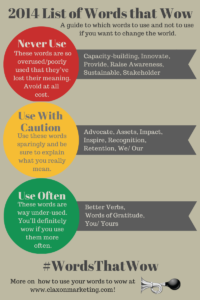
“So you actually did the research for the Wordifier yourselves? Woah, that’s a lot of work. No one does that.”
This is what an Executive Director said to me after a recent speaking engagement.
She works for an organization that empowers women and girls around the world. (For the purposes of this post, let’s call her Ellie…because that has nice alliteration with Executive Director, doesn’t it?)
Ellie had just put the word “empower” into the Wordifier and found out international organizations use the word more than any other sub-sector. She had a hunch it was overused, and they should probably look at other words, but now she had proof!
That’s the power of research–it can turn a hunch into a proven fact. And that’s powerful.
**Begin wee rant**
The social good sector invests very, very little in primary research, meaning research you collect by going out and collecting the information yourself about a topic of specific interest to you. For instance, at Claxon we were curious about how nonprofits used language so we pulled every single word off of a statistically significant sample of nonprofit websites. (You can read more about our research methodology here.)
Pretty much ever other industry invests heavily in primary research. Insurance, finance, accounting, education, consumer products, etc etc etc.
Let’s play this out.
Investment advisers don’t sit down with clients and say, “Well, I was thinking about it and, by golly, I think we should invest in this company here. Now, I don’t have any data to back that up, but I say we go for it.”
Um, no.
They say, “I’ve looked at 30 years of research and here’s how I interpret it, and, based on that, what I’d advise.”
True, in the social good sector, we tend to have fewer resources than some of these other industries (#understatement). But we’re also doing more important work. So doesn’t it make sense to have the very best information possible to do that work?!!!!!! (Ridiculous number of exclamation points purposefully added to communicate the ridiculousness of this state of affairs.)
Also true that there is value in listening to our guts. Our gut instincts tend to be very good guides. My contention is: guts+data=awesomeness.
I don’t see an easy, obvious answer to getting more funds so the social good sector can invest in primary research. It’s a long-term investment with no guarantee of near-term positive outcomes, i.e. you don’t know if what you learn will translate directly into feeding more people, curing cancer, or a better education.
But just because there isn’t an easy answer doesn’t mean we should give up. I’m certainly not going to! I’m going to keep my research soapbox handy, yes I am. Because I firmly believe more research will lead to more good in the world.
This belief is reinforced every time I talk to someone like Ellie or get an email from someone who has used the Wordifier, switched up their language and gone on to raise more money, recruit more volunteers and/or finally get their dream board member to say yes to being on their board.
**End wee rant**
Claxon invests in statistically significant research so that people like you who are changing the world know precisely how to change your words. Guessing is inefficient and time-consuming. Changing the world is a big job so you likely don’t have extra time on your hands. Am I right?
Thus, research.
Thus, the Wordifier.
Is this research expensive? Yes.
Is it worth it? Yes. Every penny. Every brain cramp. Every everything.
If you are interested in primary research specific on philanthropy and social good, check out the stupendously amazing work of Professors Adrian Sargent and Jen Shang over at Study Fundraising.
Claxon University’s course Words on a Mission also teaches organizations a lot about how to gather actionable information that will help them better dazzle their supporters and reach their goals. Worth checking out.
 [The Language Lab makes it easy for you to put research to work for you and your mission. Each installment gives you research-backed intel on one specific way you can work happier, smarter, and more effectively. To stay in the know, sign up to get Language Lab missives delivered directly to your inbox.]
[The Language Lab makes it easy for you to put research to work for you and your mission. Each installment gives you research-backed intel on one specific way you can work happier, smarter, and more effectively. To stay in the know, sign up to get Language Lab missives delivered directly to your inbox.]








 If you want your year-end fundraising to be successful, please, please, please don’t mess with your logo!
If you want your year-end fundraising to be successful, please, please, please don’t mess with your logo!